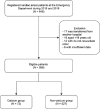Association between calcium administration and outcomes during adult cardiopulmonary resuscitation at the emergency department
- PMID: 35529024
- PMCID: PMC9069921
- DOI: 10.4103/2452-2473.342805
Association between calcium administration and outcomes during adult cardiopulmonary resuscitation at the emergency department
Abstract
Objectives: Calcium administration during cardiac arrest is limited in some circumstances, mainly due to lack of consistent evidence. This study aims to investigate whether calcium therapy administered during cardiac arrest at the Emergency Department is associated with good outcomes, including the probability of return of spontaneous circulation (ROSC), survival to hospital admission, survival to hospital discharge, and favorable neurological outcome at discharge.
Methods: We retrospectively reviewed 599 consecutive adult cardiac arrest events between 2016 and 2018. The primary outcome was the ROSC rate. Secondary outcomes included survival to hospital admission, survival to hospital discharge, and favorable neurologic outcome at hospital discharge. Multivariable logistic regression with inverse probability of treatment weighting was analyzed to examine the association between calcium administration and outcomes.
Results: Of 599 events, calcium was administered in 72 (12%) cases. The use of calcium during cardiopulmonary resuscitation (CPR) after adjusting for confounding factors was not associated with any better outcomes, including ROSC (adjusted odds ratio (aOR) 0.53, 95% confidence interval [CI] 0.24-1.17), survival to hospital admission (aOR 1.07, 95% CI 0.47-2.41), survival to hospital discharge (aOR 1.93, 95% CI 0.43-8.56), and favorable neurological outcome (aOR 6.60, 95% CI 0.72-60.74). Besides, calcium use in traumatic cardiac arrest patients was associated with unfavorable outcomes, including ROSC (aOR 0.02, 95% CI 0.00-0.09) and survival to hospital admission (aOR 0.16, 95% CI 0.03-0.84).
Conclusion: The use of calcium during an adult cardiac arrest was not associated with better outcomes. Although associations drawn from this study did not indicate the causality, given calcium during CPR was linked to poorer outcomes in traumatic cardiac arrest patients, including ROSC and survival to hospital admission.
Keywords: Calcium; cardiac arrest; emergency department; outcomes; survival.
Copyright: © 2022 Turkish Journal of Emergency Medicine.
Conflict of interest statement
None Declared.
Figures



References
-
- Kolte D, Khera S, Aronow WS, Palaniswamy C, Mujib M, Ahn C, et al. Regional variation in the incidence and outcomes of in-hospital cardiac arrest in the United States. Circulation. 2015;131:1415–25. - PubMed
-
- Srinivasan V, Morris MC, Helfaer MA, Berg RA, Nadkarni VM, Association AH. Calcium use during in-hospital pediatric cardiopulmonary resuscitation: A report from the National Registry of Cardiopulmonary Resuscitation. Pediatrics. 2008;121:E1144–51. - PubMed
-
- Kette F, Ghuman J, Parr M. Calcium administration during cardiac arrest: A systematic review. Eur J Emerg Med. 2013;20:72–8. - PubMed
LinkOut - more resources
Full Text Sources
